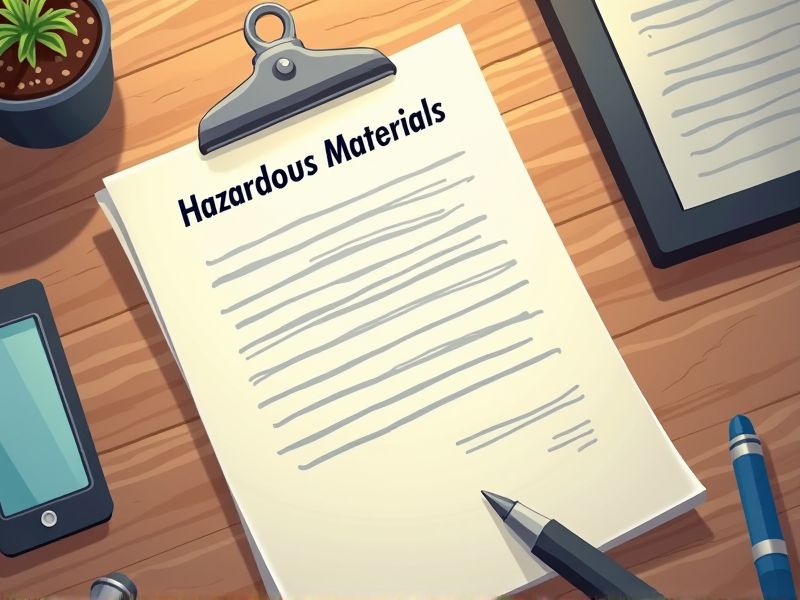
Transporting hazardous materials presents significant risks, including potential environmental damage and public safety threats, demanding rigorous regulatory compliance. Drivers handling these substances must possess specialized knowledge to mitigate dangers associated with transport accidents or exposure. Certifications ensure that drivers not only understand regulations but also have practical skills to handle emergencies effectively. Key certifications are essential for maintaining safety and compliance in Hazardous Materials Transport Driver roles.
Commercial Driver's License (CDL) with HazMat Endorsement
A CDL with a HazMat endorsement ensures that the driver is legally qualified to transport hazardous materials safely on public roads. Transporting dangerous goods involves higher risk, and the endorsement signifies that the driver has undergone specialized training to handle emergencies. Regulatory authorities require the endorsement to maintain public safety and compliance with federal guidelines. A hazmat-endorsed CDL increases confidence in the logistics chain by reducing the likelihood of accidents or spills.
Hazardous Materials Training Certification
Hazardous materials training certification ensures that drivers understand proper handling and transportation procedures, reducing the risk of accidents. Regulatory bodies mandate this certification to ensure compliance with safety standards and prevent legal repercussions. Knowledge from the certification program enables drivers to respond effectively to emergencies, minimizing potential harm. Enhanced safety protocols lead to decreased incidents, protecting both the public and the environment from hazardous spills or contamination.
Transportation Worker Identification Credential (TWIC)
The Transportation Worker Identification Credential (TWIC) is mandated for drivers handling hazardous materials because it enhances security protocols, ensuring only vetted individuals access sensitive areas. TWIC aids in the government's objective to minimize the risk of terrorism linked to transportation networks. It ensures compliance with federal security standards, integrating biometric and personal data for identity verification. This credential also streamlines processes for operators working across multiple transport sectors.
Emergency Response (HAZWOPER) Certification
Without the HAZWOPER certification, drivers lack the necessary skills to safely manage spills or exposures to hazardous materials, increasing the risk of harmful incidents. The certification provides specialized training that ensures drivers understand both federal regulations and industry best practices, which is crucial for compliance and safety. In the absence of proper certification, drivers might not effectively respond to emergencies, potentially leading to environmental damage or public health threats. Knowledge and preparedness from HAZWOPER training minimize legal liabilities for both drivers and their employers.
First Aid/CPR Certification
Possessing First Aid/CPR certification ensures a hazardous materials transport driver can respond effectively to medical emergencies that may arise during transportation. Knowledge of lifesaving techniques directly reduces potential harm to both the driver and others in case of accidents involving hazardous substances. Regulatory standards mandate such certifications to enhance overall safety and compliance within the transport industry. Proper training helps minimize the response time during critical situations, potentially saving lives and mitigating environmental impact.
Defensive Driving Certification
Obtaining a Defensive Driving Certification ensures hazardous materials transport drivers understand road safety principles, reducing the risk of accidents. A certified driver is better equipped to anticipate and react appropriately to potential hazards on the road. The certification often results in lower insurance premiums, making it economically beneficial for both drivers and employers. Regulatory bodies tend to favor companies employing certified drivers, potentially avoiding legal complications and fines.
DOT Compliance Certification
DOT Compliance Certification ensures that hazardous materials transport drivers meet federal safety regulations, reducing the risk of accidents. It provides training for properly handling hazardous materials, minimizing potential environmental and public health threats. Certification ensures drivers are knowledgeable about emergency protocols, improving preparedness for incidents. This compliance safeguards companies from legal penalties and enhances their reputation for safe operations.
Vehicle Inspection Certification
Vehicle inspection certification ensures that vehicles transporting hazardous materials are in safe and working condition, minimizing the risk of spills or accidents. It verifies that the safety features specific to handling hazardous materials are properly maintained and functional. Regulatory compliance through certification helps in adhering to legal standards, preventing potential legal penalties or fines. Certification contributes to public safety by reducing the chance of hazardous incidents that could impact communities or the environment.
Cargo Securement Certification
Cargo Securement Certification ensures hazardous materials are safely and effectively transported, minimizing the risk of accidents. Proper certification training equips drivers with necessary skills to prevent spills or leaks during transit, which could lead to environmental and health hazards. Authorities like the U.S. Department of Transportation mandate such certifications to enhance public safety and compliance with legal regulations. The certification process aids in significantly reducing liability for companies by preventing costly incidents and potential legal repercussions.
Road Safety Certification
Road safety certification ensures that drivers transporting hazardous materials possess the necessary knowledge to handle potential emergencies and mitigate risks. Proper certification reduces the likelihood of accidents by enforcing stringent safety protocols and practices. These certifications verify that drivers are trained in compliance with legal standards, helping avoid legal penalties and ensuring public safety. Safe transport practices decrease the chance of environmental contamination and costly clean-up operations.
Summary
When you obtain certifications as a Hazardous Materials Transport Driver, your qualifications significantly enhance your marketability and employability in the industry. This credential typically leads to increased job prospects, as employers prefer certified drivers due to their verified knowledge and safety practices. With certification, you can also expect potential income growth, as specialized skills often command higher wages. Furthermore, your ability to adhere to regulations reduces the risk of accidents, effectively protecting your employer's assets and reputation.
